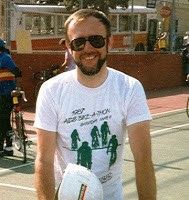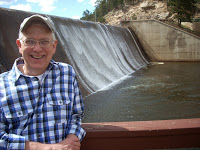a member of this group. It’s about a group of people who showed their true
colors in their loyalty to one friend and created a unique space for our entire
community. Along the South Platte River on the edge of downtown Denver, is an
area of Commons Park designated as a spot to remember those who have died of
HIV/AIDS and their caregivers. It’s called The Grove and it is one of only two
AIDS memorial gardens in this country—the other is in San Francisco. Our own
Randy Wren was part of that group that labored for seven years to make it
happen.
of the memorial grove in Golden Gate Park in San Francisco and asked, literally
as his dying wish, why can’t Denver create such a spot. Doug died of AIDS in
1993, a time when the LGBT community was focused more on the battle to undo the
infamous Amendment 2 than on the AIDS epidemic. Amendment 2, passed by Colorado
voters in 1992, prohibited any government or government agency in this state
from enacting any provisions to ban discrimination against lesbian and gay
people. (There’s an excellent exhibition on that history outside this door in
The Center’s lobby.) And it was a time of still rampant AIDS phobia.
for The Grove. They weren’t the usual gaggle of community activists and
politicos. They included socialites, arts community supporters, an attorney,
and an Episcopal priest. Most were not gay. They organized a non-profit group
called The Grove Project, got 501c3 IRS status so they could collect funds, and
began the long process of taking on the bureaucracy of the city’s Parks
Department.
negotiations dragged on for years. At first, the area in front of the
performing arts complex on Speer Blvd was proposed. The city objected that
theatre and concert goers wouldn’t want to be reminded of the awfulness of AIDS
on their nights out on the town. Another location in a park in southeast Denver
was suggested but that would have left the memorial far from the Capitol Hill
neighborhood that was most affected by AIDS.
that time, the area was just beginning to be developed. There was a quiet,
somewhat out of the way spot in a new park—Commons Park—that the city was
planning. That fit the criteria of being visible, centrally located and quiet
enough to promote the atmosphere desired.
contemplation. It was landscaped very simply with trees, natural grasses and
shrubs, and some rocks. A simple inscription reads: “Dedicated to the
remembrance of those who have lost their lives to AIDS and to their loving
caregivers who helped them live out those lives with dignity.”
2000. Doug McNeil’s loyal and persistent friends accomplished his dream after
seven years of work.
in a recessed corner of Commons Park, near 15th Street and Little
Raven Street. It is surrounded by high priced condos and apartments but it is
still a quiet and attractive area.
it up, refresh the landscaping and, most importantly, make the community aware
that this historical and spiritual resource exists. In recalling all the
individuals who battled, and continue to battle AIDS, we remember how our community
grew from that experience. We remember those we’ve lost. We remember when being
gay changed from just giving the most fabulous parties to a truly mature
community of caregivers and advocates. We remember our past and that we have a
history. A history that is the root of our present and future.
quiet moments there remembering. And maybe you can help in its renewal. You too
can show your true colors.
the Author
then grew up in San Francisco, and is now growing up in Denver. He retired from
work with non-profits in 2009 and now bicycles, gardens, cooks, does yoga,
writes stories, and loves to go out for coffee.


